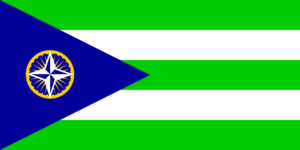Sarolasta
| Sarolasta | |
 Flag | |
| Country | Kiravian Federacy |
| Capital | Sarolasdra |
| Population | Q,XYZ,000 |
| President | D.H. Fanakatin |
| Chair of the Council | A.D. Vikontarév |
| Stanora seats | 23 |
| Official languages | Australic Coscivian? |
| Postal Abbreviation | N/A |
Sarolasta (Saxon: "Moonlight") is a theme of the Kiravian Federacy comprising an island chain south of Crona in the Polynesian Sea, centred on the main island of Grand Sarolsta and including five smaller island groups to its north and south.
Geography
Federal subjects
| Flag | Classification | Subject name | Capital City | Governor | Population (2030 Census) |
|---|---|---|---|---|---|
| Overseas Territory | StateA | Sarolasdra | Taxus Elvoren | 1,984,000 | |
| Overseas State | StateB | Saar-Kírūra | Séamlus Ripov | 1,984,000 | |
| Overseas State | StateC | WIIC City | Antonin R. | 1,984,000 | |

|
Overseas Territory | Tarunua | Krak des Cheveaux | Maccus Donaldus | 1,984,000 |
| File:Flag of slowjamastan.png | Overseas State | StateE | Alofasar | Nikoláus Déimorian | 1,984,000 |
| Overseas State | StateF | Taigovæloa | Tadéus Tersinêv | 1,984,000 | |
| Overseas State | StateG | Halotisar | Lentia Tertakin | 1,984,000 | |
| Overseas State | StateH | Ngatra | Rallin Soterion | 1,984,000 |
History
[Austronesian inhabitants]
[Coscivian colonisation]
In 1584 AD, the Imperial Bank of Kintær's Austral Ocean Armada under the command of Levar Trimartolon anchored at Kapenga Island in modern-day [island group/state name TBD], lingering for several weeks to make repairs, replenish supplies, and sample the local flavours. Trimartolon claimed Kapenga for the Marble Emperor but did nothing to secure this claim before continuing on his journey.
Kiravian colonisation of Sarolasta began in earnest in 1592 AD with the construction of a stockade by Ivo Siguatera on the site of modern-day Kanoka.
[During KFR exile]
[Post-Restoration]
Politics & Governance
Sarolasta is one of five themes of the Kiravian Federacy, the alongside the Kiravian Federal Republic, Lesser Kirav, Sydona, the Melian Isles, and the Overseas Regions. The states and territories that make up Sarolasta have, by compact, created a Commonwealth Council and President of the Commonwealth to exercise thematic functions. The Commonwealth Council comprises the ranking members of the state and territorial legislatures, as well as [relevant subset of cabinet officials]. The President of the Commonwealth is elected by [the Nigerian system] every 42 months and has some *pro forma* duties regarding the certification of electoral votes and thematic resolutions, in addition to serving as a public advocate for the people of Sarolasta.
Due to its strong adherence to Catholicism and demand for higher social spending and development aid, Sarolasta is a stronghold for the Caritist Social Union in elections to the Stanora, often electing candidates of a pronounced Social Christian ideological bent that reinforce the fiscal left wing of the caucus.
Society & Culture
The majority of the Sarolastan population is of indigenous Austronesian stock with some degree of Éorsan Coscivian admixture. 25-32% are fully or primarily of Éorsan Coscivian ancestry. There are many specific mestiśuv ethnicities formed by intermarriage between one Coscivian subgroup and one indigenous people, in a fascinating confluence of the Coscivian tuva system with indigenous tribal networks. The largest of these hybrid communities are the Paisonic-Aymang and Paisonic-Ailmao. The Éorsan Coscivian contribution to the Sarolastan cultural mélange is provided mainly by Paisonic, Lusan, Kastrovan, Eskean, Tebnan, Kerēgulan, Vèuskan, [the usual seafaring groups], Æonaran/Umcaran, and Westcoastmarine/Serradan Coscivians.
There is a significant minority of Corummese and mixed Corummese-Polynesian descent.
1,896 ethnic Loa belonging to the Uelamanpu'ue Clan live in Sarolasta, mostly in Leviti.
During the exile period, the Federalist government implemented major reforms on Sarolasta to prevent rebellion. This included recognising all native and mestiśuv communities practicing monotheism, monogamy, tuva, and [other key Coscivian hallmarks] as Coscivians and inviting their customary kings and chieftains to pledge fealty to the Basswood Emperor.
[Leftover minorities from other nations’ colonisation attempts?]
[Languages] [Creole languages]
76% of Sarolastans adhere to the Catholic Church, overwhelmingly to the Coscivian Rite. Minority Christian sects include the Coscivian Orthodox and Independent Orthodox churches, Æglasta-i-Xristul, and Mormonism. Some Kastrovans and Kastrovan-Mestizos are Insular Apostolic. Among the Éorsan Coscivian population there are minorities adhering to Ruricanism, Iduanism, and Komarism.
Sarolasta has a Muslim community.
Cuisine

Economy
Sarolasta has a middle-income, newly-industrialising emerging market economy. With the passage of the Common Market (Sarolasta) Act of 2024, the provinces of the Sarolastan theme form a single market with one another. Due to its special development needs, Sarolasta is administered as a distinct customs territory from the main Kiravian Customs Area (which encompasses the Federation, South Kirav, Èusa, and Atrassica). Although it is the least-developed part of the Kiravian Federacy, it has a stronger growth prospectus than many struggling industrial and agricultural provinces in Second and Third Kirav.
Brain drain of educated Sarolastan professionals to other Kiravian regions and abroad has been a major drag on the region's economic development. This is a particularly visible phenomenon in the medical field: In Cascada State, Sarolastan-born residents account for 9.12% of registered nurses and 23.46% of licensed physician's assistants, but only 2.52% of the total population. To mitigate this, the Sarolastan provinces and members of the Federal Stanora are working toward a programme that will expand tuition subsidies in certain technical fields at Sarolastan public universities, contingent upon students' commitment to work only in the Sarolastan theme for 10 years or else repay the cost of their education.
Agriculture
Fisheries
Fishing has been crucial to livelihood of this island region from the arrival of the first Austronesian settlers to the rise of modern mechanised pelagic trawling.